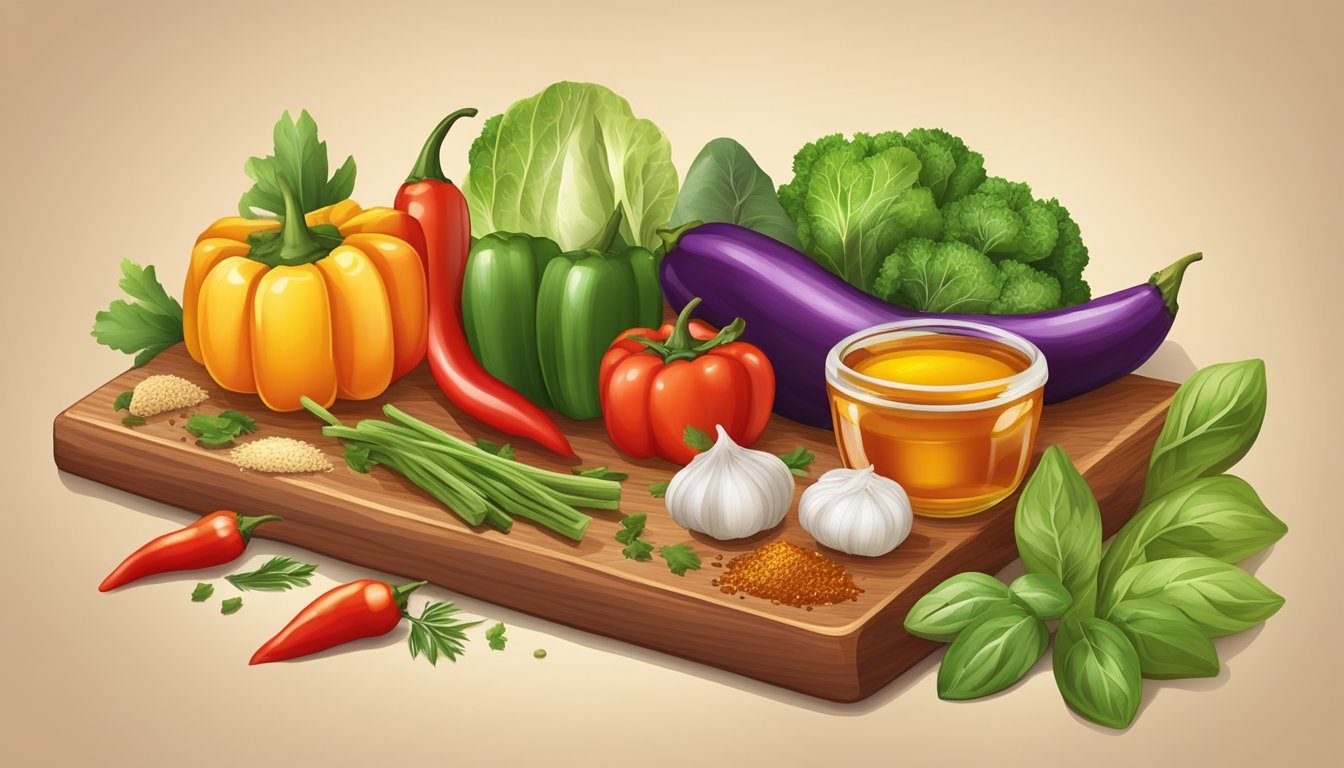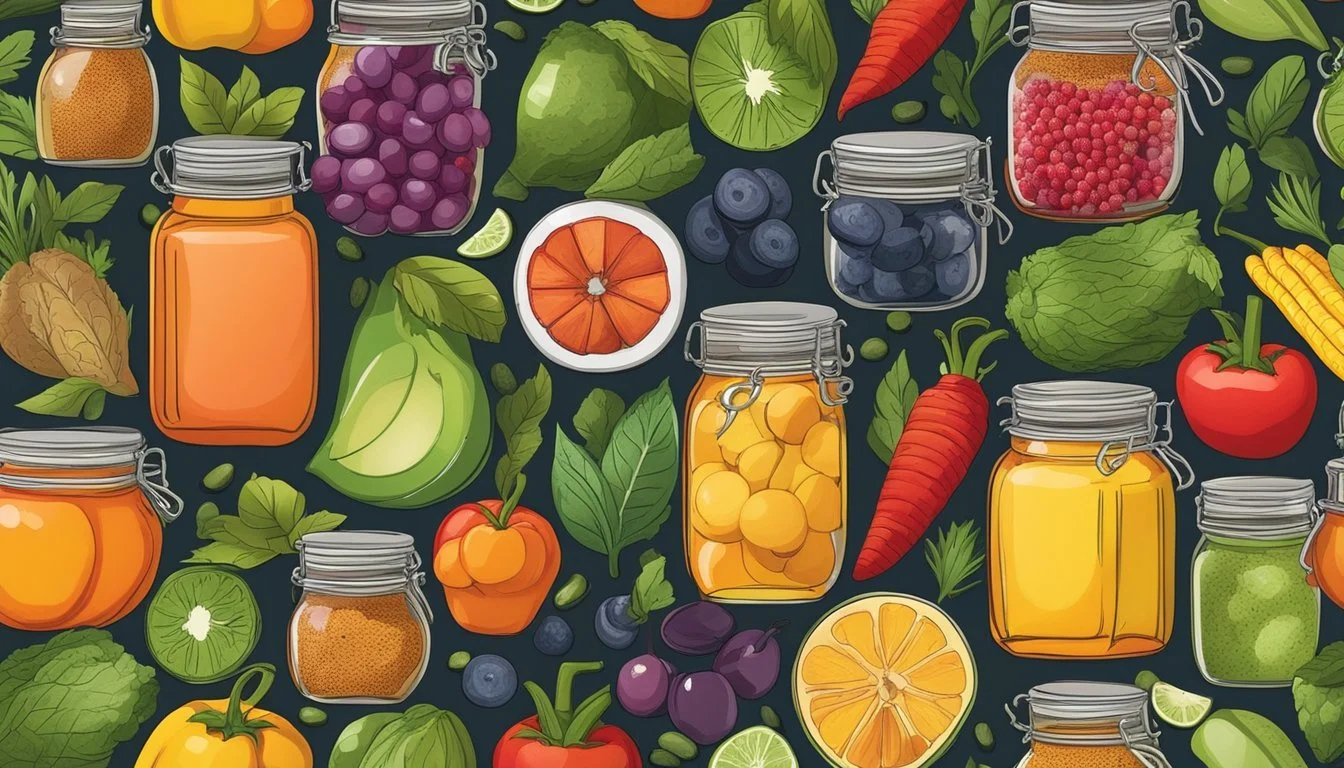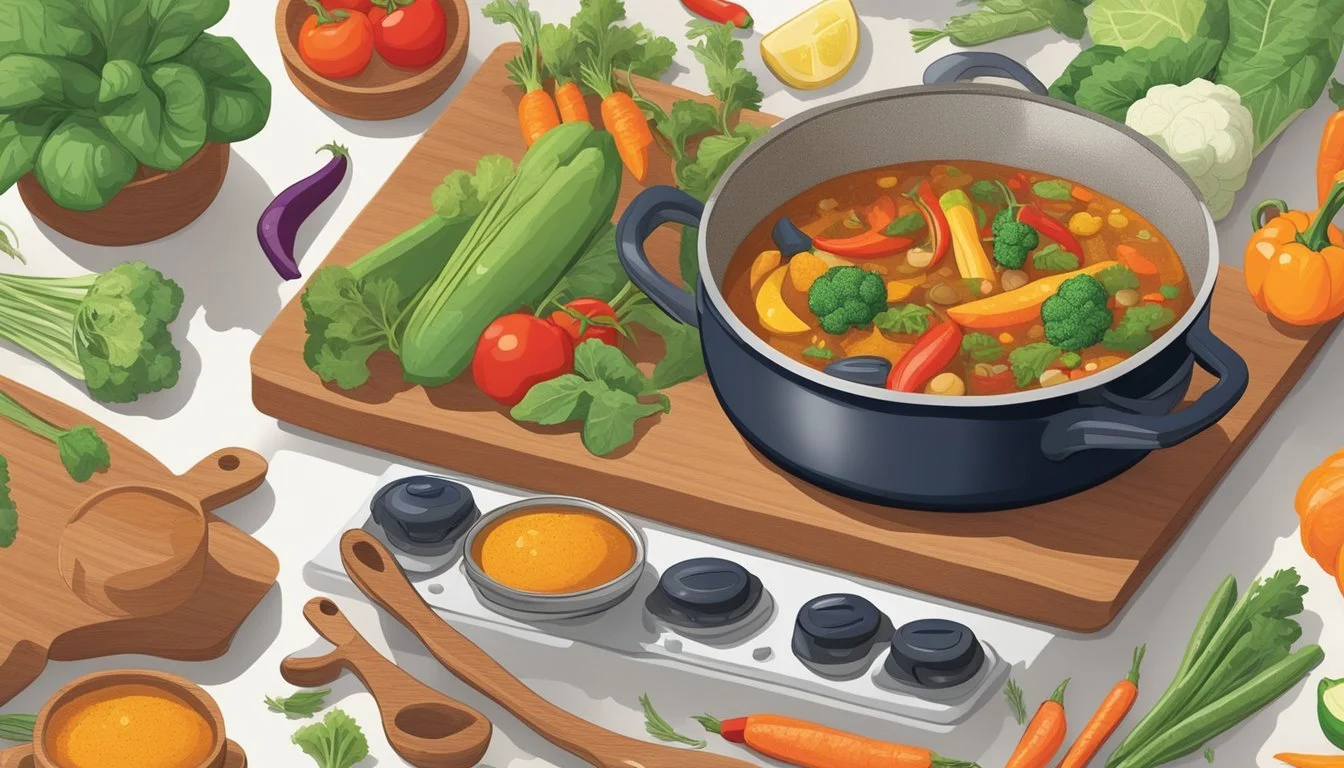Vegan Swicy Delights
Savoring the Fusion of Sweet and Heat in Plant-Based Cuisine
The fusion of sweet and spicy flavors has long captivated the palates of food enthusiasts around the world. Vegan cuisine, known for its inventive use of plant-based ingredients, has embraced this tantalizing combination to create an array of dishes that satisfy both the sweet tooth and the craving for heat. These vegan "swicy" recipes offer a symphony of tastes, featuring natural sweetness from fruits and vegetables balanced by the piquant zing of spices and chili-infused condiments.
As the interest in plant-based eating continues to grow, so does the variety of vegan recipes that cater to this dynamic flavor profile. The key to crafting mouth-watering sweet-spicy vegan recipes lies in the selection of ingredients that bring depth and complexity to a dish. Coconut milk, for instance, provides a creamy base that carries the heat from spices like curry powder, while ingredients like tahini and soy sauce add a savory note that complements the overall sweetness.
Incorporating global influences, vegan 'swicy' dishes can range from hearty soups and stews to vibrant stir-fries and sauces. Cooks experimenting with plant-based ingredients have the freedom to adjust the heat level and sweetness to their preference, allowing for personalized culinary experiences that don't compromise on flavor. These recipes not only cater to those following a vegan lifestyle but also invite others to explore the rich possibilities within plant-based cooking.
Essentials of Vegan Spicy Cooking
In vegan spicy cooking, the key is to balance rich, plant-based proteins with a variety of herbs and spices that enhance flavor and provide health benefits. Understanding these ingredients and how to use them will result in delicious, nutritious meals.
Understanding Plant-Based Proteins
Plant-based proteins are fundamental to vegan nutrition, serving as the building block for a healthy and balanced diet. Tofu and edamame are excellent sources of protein, providing the necessary amino acids while being low in fat and rich in fiber. Tofu, with its subtle taste, easily absorbs flavors from sweet and spicy glazes while edamame, commonly enjoyed as a snack, can be enjoyed seasoned with spices.
The Role of Spices and Herbs in Vegan Cuisine
Spices and herbs are the heart of vegan cuisine, imparting depth and layers of flavor without the need for animal products. Spices like cayenne, which brings heat, and cinnamon, which can add warmth and a hint of sweetness, are essential. Garlic and ginger not only contribute a spicy kick but are also celebrated for their health benefits, potentially lowering blood sugar levels and providing anti-inflammatory properties. Adding herbs and spices not only increases the dish's flavor complexity but can also boost the meal's nutritional profile by allowing for less reliance on salt and sugar.
Sweet and Spicy Vegan Recipes
In the realm of plant-based cuisine, sweet and spicy recipes offer a delectable balance of flavors that can cater to a variety of taste buds while providing substantial nutrition. These dishes range from simple appetizers (What wine goes well with appetizers?) to robust main courses, and even stretch into the sweet arena of desserts and snacks.
Appetizers to Ignite Your Palate
Edamame with a Sweet and Spicy Twist: One can easily enhance the natural savory taste of edamame by tossing them in a mixture of maple syrup, chili flakes, and a pinch of sea salt. This appetizer is not only fiber-rich but also serves as a quick and nutritious start to any meal.
Vegan Spiced Nuts: A blend of almonds, cashews, and pecans, glazed with a combination of agave nectar, cinnamon, and cayenne pepper, makes for a crunchy, protein-packed snack. These nuts are gluten-free, dairy-free, and egg-free, meeting a wide array of dietary needs.
Main Dishes with Hearty Flavors
Sweet and Spicy Tofu Stir-fry: This dish combines high-protein tofu with a medley of bell peppers, broccoli, and cabbage in a sauce that balances sweetness with heat, using ingredients like agave nectar or brown sugar and chili paste. It's a nutritious, flavor-packed entrée, full of essential vitamins and minerals.
Spicy Vegan Noodles: Utilizing rice or ramen noodles, this easy-to-make dish is customizable with a sauce crafted from soy sauce, hot chili paste, rice vinegar, and a sweetener such as maple syrup. It can also cater to those counting calories and carbohydrates, as one can adjust the portion size and noodle type to fit dietary goals.
Desserts and Snacks
Sweet and Spicy Roasted Chickpeas: These can serve as a dessert or a snack. Chickpeas, when roasted until crisp and tossed in a sweet and spicy seasoning blend, provide a satisfying treat rich in fiber and plant-based protein.
Sweet and Spicy Chocolate Bark: Vegan dark chocolate, infused with a hint of chili and topped with a sprinkle of sea salt and chopped nuts, creates a dessert that hits the perfect balance between sweetness and spiciness. It's a dairy-free treat that chocolate enthusiasts can savor.
Cooking Techniques & Tips
Effective cooking methods enhance the natural flavors of plant-based ingredients while keeping the prep and total time manageable. This section focuses on oven and skillet techniques, as well as no-oil baking tips for creating delicious vegan sweet and spicy dishes (What wine goes well with spicy dishes?).
Mastering the Oven for Perfect Vegan Dishes
The oven is a versatile tool for creating an array of sweet and spicy vegan delights. For roasted nuts—a key ingredient in sweet potato granola—preheat the oven to 350°F and roast for 10-15 minutes until golden brown, stirring halfway through. Always monitor closely to prevent burning. When preparing crispy tofu, press the tofu to remove excess moisture, then toss it with a blend of spices and a bit of cornstarch before baking at 400°F for 25-30 minutes, flipping the pieces once.
Skillet Secrets for Plant-Based Meals
A skillet excels at sautéing and caramelizing. Begin by heating the skillet over medium flame. If including onion, let it cook until translucent before adding ingredients like garlic or veggies which require less cooking time. For dishes like sweet and spicy tempeh (What wine goes well with tempeh?), simmer the tempeh in water with a pinch of salt first, then pan-fry until the sauce coats it well, absorbing the flavors for a savory bite.
No-Oil Cooking on a Baking Sheet
For an oil-free option, line a baking sheet with parchment paper to prevent sticking. Vegetables like sweet potatoes can be cubed and seasoned, then spread evenly on the sheet. Roast in the oven until tender and edges begin to crisp. To ensure even cooking, stir the veggies halfway through. This technique allows for healthier, easy-to-prepare meals with minimal cleanup. Store any leftovers in an airtight container to maintain freshness.
Sauces & Condiments: The Key to Flavor
The right sauces and condiments can transform any plant-based dish, infusing it with a delightful blend of sweet and spicy flavors. Careful attention to ingredients like sugar, sodium, and spices ensures a harmonious balance that can enhance the taste of any recipe.
Homemade Vegan Sauces
In the realm of vegan sauces, a striking balance between sweet and spicy elements is crucial. Maple syrup serves as a wonderful plant-based sweetener, devoid of cholesterol and saturated fats, and is often combined with tamari or soy sauce to introduce a rich umami flavor with a controlled sodium content. Sesame oil adds a nutty depth, while sriracha provides a piquant kick. A popular fusion includes a maple glaze incorporating ginger and garlic for a flavor profile that dances on the palate. Care should be taken to use kosher salt conservatively to maintain the healthful aspect of these sauces.
Spice Blends and Seasonings
One cannot overlook the importance of spice blends and seasonings in crafting the perfect sweet-spicy vegan sauce. Essential spices like cayenne pepper and red pepper flakes deliver the heat without overshadowing the core flavors of the dish. When used judiciously, garlic and ginger forge a taste that is aromatic and warming. Crafting a spice mix at home allows for the alteration of the hot and sweet levels to suit individual preferences and dietary needs, creating a customizable eating experience with every meal.
Sweets & Flavors
Incorporating a balance of sweet and spicy components in vegan dishes creates complex flavors that entice the tastebuds. This section explores the interplay between sweetness and heat, particularly focusing on how to infuse this combination into nuts and seeds—a nutritious source of carbohydrates, fiber, vitamins, and minerals.
Balancing Sweetness and Spice
Achieving the perfect sweet-spicy harmony requires attention to ingredients that offer both flavorful impact and health benefits. Maple syrup and brown sugar provide natural sweetness with hints of caramel, while cinnamon and cloves add warming, spicy undertones without overpowering the palate. For an adventurous heat, chili flakes and cayenne pepper can be introduced in moderation, ensuring the spice enhances rather than dominates the flavor profile.
Creating Sweet and Spicy Nuts and Seeds
Nuts and seeds such as almonds, cashews, pecans, walnuts, hazelnuts, brazil nuts, pepitas, and peanuts are not only rich in essential nutrients but also provide a versatile canvas for sweet and spicy seasonings.
Sweet Spice Mix for Nuts and Seeds:
2 Tbsp of maple syrup (bold, sweet flavor with complexities)
1 Tsp cinnamon (sweet warmth)
A pinch of cayenne pepper (sharp heat)
A touch of rosemary or cloves (aromatic depth)
Gently tossing the nuts in the sweet spice mix and baking them at a low temperature allows the flavors to penetrate and the textures to crispen, resulting in a delectable, crunchy snack.
Nut Nutrition Highlights:
Calories: Varies
Carbohydrates: Primary energy source
Fiber: Promotes digestive health
Protein: Essential for muscle repair and growth
Fats: Healthy fats support heart health
Vitamins & Minerals: Different nuts offer various benefits, like magnesium and vitamin E
These flavorful tidbits can serve as a standalone snack or enhance plant-based recipes with both their nutrient profile and their sweet-spicy kick.
Nutritional Advantages of Vegan Sweet-Spicy Dishes
Vegan sweet-spicy dishes offer a unique combination of flavor and nutrition, focusing on plant-based ingredients that provide essential nutrients while reducing the intake of unhealthy components like saturated fat and cholesterol.
Macronutrients and Micronutrients in a Vegan Diet
Vegan diets are rich in macronutrients such as carbohydrates, protein, and healthy fats, which are necessary for energy, tissue repair, and various bodily functions. In sweet-spicy vegan recipes, ingredients like tofu and legumes provide protein, while whole grains and vegetables contribute complex carbohydrates and fiber, supporting digestive health. For example, tofu is not only a versatile protein source but also contains iron and calcium.
In addition to macronutrients, these dishes are packed with micronutrients—a range of vitamins and minerals that support overall well-being. Spices and herbs used in these recipes aren't just about taste; they often contain phytonutrients and antioxidants, substances that can protect against diseases. Vegan sweet-spicy dishes commonly incorporate a variety of vegetables that offer vitamins A, C, and K, as well as potassium and magnesium, all whilst keeping sodium and sugar levels in check to maintain a balanced and healthy diet.
Furthermore, by capitalizing on the natural sweetness of ingredients like fruits or agave nectar, vegan sweet-spicy dishes can reduce refined sugar consumption. Opting for natural sweeteners and spices also helps keep the caloric content lower compared to dishes that contain processed sugars and syrups.
Due to the absence of animal products, these dishes naturally eliminate cholesterol and typically have low levels of saturated fat, reducing the risks associated with heart disease and stroke. Instead of animal fats, they rely on plant-based fats such as avocado or nuts, which contribute essential fatty acids and help the body absorb fat-soluble vitamins.
The emphasis on whole, minimally processed foods in vegan sweet-spicy recipes means that these dishes are often lower in calories and higher in nutrients compared to their non-vegan counterparts, supporting a healthy lifestyle without sacrificing flavor.
Dietary Considerations and Substitutions
When preparing vegan sweet-spicy dishes, cooks must consider various dietary restrictions such as gluten allergies and sugar intake to ensure the meal is enjoyable and safe for everyone.
Gluten-Free and Allergy-Friendly Options
For those avoiding gluten or with specific food allergies, traditional ingredients can often be substituted without sacrificing flavor or texture. Here are some specific substitutions:
Soy Sauce: Replace with tamari, which is a gluten-free soy sauce alternative, making sure it is labeled as such as some tamari blends may still contain small amounts of gluten.
Wheat-Based Noodles: Use noodles made from rice, quinoa, or other gluten-free grains.
Flour for Thickening: Opt for cornstarch or arrowroot powder in place of flour to achieve the same thickening effect in sauces and soups.
It is essential for anyone with serious allergies to read labels carefully, as products can vary in their composition.
Low-Sugar and Low-Sodium Alternatives
Maintaining a healthy balance of sugar and sodium is crucial in a plant-based diet. Here’s a concise guide to balancing these elements in vegan sweet-spicy recipes:
Sugar: Instead of refined sugar, use natural sweeteners like maple syrup or agave nectar. They offer a rich sweetness and are plant-derived, aligning with the vegan ethos.
Sodium: High sodium can be a concern, so one can reduce the amount of added salt and use herbs and spices to enhance the flavor profile. When a recipe calls for soy sauce, opt for a low-sodium version or use smaller amounts of regular soy sauce complemented with other seasonings.
By considering these dietary alternatives, one can easily adapt vegan sweet-spicy recipes to meet a range of dietary needs without compromising on the delectable fusion of flavors that characterize these dishes.
Preparation and Cooking Times
When it comes to plant-based sweet and spicy (Swicy) recipes, the preparation and cooking times are pivotal for a successful culinary experience. One aims to optimize nutrition without sacrificing flavor, ensuring that time management in the kitchen yields delicious results efficiently.
Quick and Easy 30-Minute Vegan Recipes
For those short on time, 30-minute recipes are the quintessence of efficiency. With prep time often taking a mere 5-10 minutes, these dishes are designed for busy cooks looking to whip up something nutritious and flavorful without the hours-long commitment.
Sweet and Spicy Tempeh: Total time from start to finish can be as quick as 30 minutes. One cuts the tempeh, simmers it briefly to improve texture, and then cooks it with the sauce until everything is thoroughly combined and flavorful.
Spicy Tofu Balls: While the name might suggest complexity, this dish can be crafted in under 30 minutes. Sizzling tofu balls are drenched in a zesty tomato sauce, making a convenient, protein-rich meal.
It's crucial to note that the actual cooking time is often less than the total time. The swift nature of these dishes ensures that one can enjoy a balanced, spicy-sweet meal that also respects the intricacies of nutrition and taste, even on the busiest of days.
Efficient Cooking for Multiple Servings
Cooking in larger batches can be a clever approach to time management, as it provides multiple servings from a single cooking session. Preparing dishes that are scalable can save time in the long run and provide additional meals for later enjoyment. Leftovers can be stored in an airtight container to maintain freshness and can offer convenient meals throughout the week.
Vegan Spicy Mayo: Can be made in 5 minutes and stored up to a week, granting any sandwich or salad a creamy zest.
Tahini Noodles: The sauce can be prepared ahead, and noodles cooked in bulk. One can efficiently serve several people or secure future meals that require nothing more than a quick stir in the pan.
When organizing recipes for multiple servings, it's crucial to consider not only the prep time but also the total cooking time. Anticipating extended cooking times for larger quantities helps to maintain food quality, nutrition, and taste. Proper storage practices are paramount for ensuring that leftovers retain their intended culinary impact.
Presentation and Serving Suggestions
When presenting vegan swicy dishes, it's essential to focus on the visual appeal and how the meal comes together. Utilizing vibrant garnishes and thoughtful dish pairings can elevate the experience from simple sustenance to a culinary adventure.
Plating Techniques for Instagram-Worthy Dishes
For an Instagram-worthy presentation, chefs should concentrate on color contrasts and sauce application. A drizzle of sweet-spicy sauce can add visual interest and a flavor boost. Strategically place garnishes like cilantro, green onion, and sesame seeds to introduce texture and fresh pops of color. An asymmetrical arrangement of these elements can create a dynamic and modern look. For appetizers, smaller plates with a clean rim allow the dish to stand out, while for main courses, a larger canvas can be used.
Dish Type Garnish Presentation Tip Appetizer Cilantro Use as a delicate highlight to the plate. Main Course Green Onion Slice thinly and sprinkle for a sharp visual and flavor contrast. Dessert Sesame Seeds Sprinkle over desserts for a subtle crunch and aesthetic appeal.
Pairing Dishes for a Complete Meal
Choosing complementary dishes for a meal ensures a harmonious taste experience and can make a significant impact on the overall rating and review. An appetizer like spicy glazed tempeh can be paired with a milder soup or salad as a precursor to the main course, perhaps a hearty curry with coconut milk and sambal. For dessert, a sweet-spicy fruit compote offers a refreshing end. It's important that each course balances the others in terms of flavor intensity, portion size, and temperature.
Course Pairing Suggestion Note Appetizer Spicy Glazed Tempeh Kicks off the meal with a burst of flavor. Main Course Vegan Curry with Coconut Milk and Sambal Satisfies with rich, complex flavors and heat. Dessert Sweet-Spicy Fruit Compote Cleanses the palate and provides a refreshing finale.
Understanding Vegan Recipe Adaptations
When adapting traditional recipes to vegan versions, key considerations are maintaining flavor, ensuring nutritional value, and achieving similar textures. These adaptations involve thoughtful ingredient swaps and creative use of spices and herbs.
The Art of Converting Traditional Recipes to Vegan
A successful transformation of a traditional recipe often hinges on finding the perfect plant-based substitutes for animal-based ingredients. The goal is to retain the essence of the dish while making it suitable for a vegan diet. Spices and herbs play a pivotal role here, as they can introduce the depth and complexity often provided by non-vegan components. A gluten-free, spicy vegan dish might leverage a robust blend of cumin, coriander, paprika, and cayenne pepper to compensate for the umami traditionally achieved with meat.
Common Substitutions:
Milk: Plant-based milks like almond, soy, or oat milk can replace dairy milk.
Meat: Textured vegetable protein (TVP), lentils, or tempeh can stand in for ground meat.
Eggs: Flax or chia seeds soaked in water can serve as a binder similarly to eggs.
Cheese: Nutritional yeast or cashew cheese can mimic the flavor of cheese.
Ingredient Swaps for Everyday Cooking
Everyday cooking demands versatile substitutions that are both healthy and accessible. Nutrition is paramount in vegan cooking, so swaps should not only aim to imitate the taste and texture but also the nutritional profile of the original ingredients. Tofu, for instance, is an excellent dairy-free and egg-free alternative that provides protein, while coconut milk adds creaminess to recipes without the dairy. Many vegan recipes also capitalize on the versatility of legumes, which offer both protein and fiber.
Here's a simple guide to key vegan swaps:
Traditional Ingredient Vegan Substitute Benefits Butter Plant-based butters Dairy-free, often with healthy fats Cream Coconut or cashew cream Adds richness, while remaining gluten-free Honey Maple syrup or agave Plant-based sweetness suitable for vegans Gelatin Agar-agar Animal-free setting agent, great in desserts
In both adaptations and daily vegan cooking, the inclusion of substitutions that are rich in spices and maintain a healthy profile ensures that vegan dishes are not only nutritious but also satisfying and flavorful.
Building a Vegan Pantry
A well-stocked vegan pantry is essential for creating a wide range of sweet-spicy dishes that are both healthy and flavorful. It should include staples that allow for a balanced approach to nutrition and taste.
Staples for the Sweet-Spicy Vegan Kitchen
For the perfect blend of sweet and heat in vegan cooking, one should stock up on:
Sweeteners: Maple syrup is a popular plant-based option, giving dishes a rich, caramel-like sweetness.
Spices and Herbs: Essential for heat, spices like cayenne and smoked paprika are must-haves. For an aromatic touch, herbs like rosemary are useful.
Nuts and Seeds: Almonds, cashews, and sesame seeds add crunch and nutrition.
Healthy Fats: High-quality oils, such as olive oil, are key for cooking and dressings. For an oil-free choice, stock tahini or mashed avocado.
When assembling these ingredients, it’s important to ensure they are indeed vegan and do not contain any hidden animal products, which can sometimes be found in sugars or flavorings.
Long-Term Storage and Preserving Flavors
Maintaining the quality of pantry items involves proper storage techniques:
Airtight Containers: Store spices, herbs, and nuts in airtight containers to keep them fresh and prevent them from taking on moisture or other flavors.
Cool, Dark Places: Most pantry staples, including sweeteners like maple syrup, should be stored out of direct sunlight to preserve their flavors.
Oil-free Sauces: These can be refrigerated to extend their shelf life. For leftovers, an airtight container can keep them fresh for a few days.
One's pantry should balance health considerations, such as reducing salt and sugar, with the need for robust, flavorful ingredients that bring vegan dishes to life.
Social Media Engagement
In the realm of vegan culinary arts, social media platforms like Pinterest and Instagram serve as bustling hubs for sharing and discovering a vast array of plant-based sweet-spicy recipes. Users are not only seeking inspiration but also looking to interact with fellow enthusiasts in a supportive community.
Sharing Recipes and Tips on Pinterest
On Pinterest, visual appeal drives the sharing of vegan recipes. In creating a Pinterest board, users often curate a mix of colorful and tempting images linked to sweet-spicy vegan recipes. For effective engagement, pin descriptions should be concise and include key ingredients, cooking tips, or nutritional facts, compelling users to save and revisit pins. Utilizing hashtags, such as #VeganSwicy or #PlantBasedRecipe, helps increase the discoverability of pins to those seeking specific content. Additionally, including ratings within the pin's image can provide immediate feedback on recipe popularity, while comments serve as a space for personal reviews and modifications.
Pin Components for Increased Engagement:
High-quality images of the finished dish
Concise descriptions with key ingredients
Relevant hashtags like #SpicyVegan
Visible ratings and call-to-action for reviews
Engaging with a Community of Vegan Food Enthusiasts
Instagram's interactive features enable a deeper level of engagement within the vegan community. Users frequently share their own recipe creations or variations of established ones through visually stimulating posts and stories. Instagram stories can feature polls, question boxes, and sliders to gauge audience preferences for ingredients or spiciness levels. A critical aspect is prompt and thoughtful interaction in the comments section of each post, which may include sharing adjustments made to recipes or responding to inquiries about ingredient substitutions.
Users can encourage community participation by:
Hosting Instagram Live cooking sessions
Replying to comments and direct messages to build rapport
Using Instagram Reels for condensed recipe tutorials
Inviting followers to share their own interpretations under a branded hashtag, e.g., #VeganSwicyChallenge
Advanced Vegan Sweet-Spicy Cooking Techniques
When preparing vegan sweet-spicy dishes, chefs should look beyond simple heat, balancing nuanced flavors while considering nutrition. This section unpacks two key areas: sourcing inspiration from global cuisines and crafting flavors through scientific principles.
Exploring World Cuisines for Inspiration
In advanced vegan cooking, a chef’s spice palette is enriched by international influences. Dishes such as chraime, traditionally a spicy fish stew, can be revolutionized with tofu, transforming it into a fusion of sweet, heat, and umami. International Hot & Spicy Food Day, celebrated on January 16, is an excellent opportunity to showcase innovative vegan dishes like salsas, curries, and even kimchi—all with a sweet-spicy twist. Inspiration may come from:
Mexican cuisine: Add layers of flavor with cumin, chipotle, and sweet agave.
Indian cuisine: Create complexity by blending sweet jaggery with fiery garam masala.
Korean cuisine: Combine gochujang and maple syrup for a depth of flavorful heat.
By integrating these international spices and sauces, chefs can craft complex vegan recipes that are both nutritionally sound and exploding with robust flavors.
The Science of Flavor Development
Advanced cooking techniques involve understanding how flavors develop and interact. Sweet and spicy components, when combined correctly, lead to a flavor profile that excites the palate without overwhelming it. Sweetness can be derived from natural sugars found in fruits like pineapple, while heat typically comes from capsaicin in chili peppers. To achieve both rich flavor and nutritional balance, chefs must carefully select their ingredients, considering both sodium and sugar content. Additionally, they can employ methods such as:
Reduction: Intensifies flavors by gently simmering the sauce to evaporate water content, thickening it and concentrating the sweet and spicy elements.
Caramelization: Elevates natural sugars in vegan ingredients, adding a delightful complexity.
Through these techniques, chefs ensure that their sweet-spicy vegan dishes are not only tantalizing but also align with dietary considerations, showcasing the culinary prowess that modern vegan cuisine can offer.
Conclusion
Embracing a vegan lifestyle does not limit one's culinary experience; it expands it, especially when exploring sweet and spicy, or "swicy," flavor profiles. Plant-based eaters have a multitude of options that are both satisfying and nutritionally robust. These recipes leverage the natural flavors of vegetables, legumes, and grains, enhanced with spices and sweeteners to create a harmonious balance.
Health Benefits: Consumers of vegan recipes can be assured of a meal that's generally lower in saturated fats and rich in nutrients. Addition of ingredients like tofu, beans, and a variety of vegetables ensures a wholesome and healthy meal, aligned with nutritional needs and ethical choices.
Flavor Diversity: Vegan recipes are far from monotonous. Swicy recipes are a testament to that, offering a plethora of tastes from around the globe. Homemade sambals, curries, and sauces add a kick, while natural sweeteners and fruits lend a gentle sweetness.
Ease and Confidence: With simple ingredients and straightforward methods, these recipes build confidence in the kitchen. Beginners and seasoned chefs alike can delight in the ease with which these plant-based meals come together.
Nutrient-Dense Options: Vegan cooking is often nutrient-dense, providing ample vitamins and minerals. Spicy and sweet recipes can be part of a balanced diet, contributing to overall well-being.
In short, one can adopt a swicy vegan diet and remain confident in receiving a variety of flavors, nutrition, and health benefits. Whether it's a zesty soup or a rich, creamy sauce, these recipes offer a delectable journey for the taste buds, while staying true to plant-based principles.













